Duplicate content can be defined as content that appears on the web in more than one place. It can also mean similar or exact copies of content on other websites or on different pages on the same website. To resolve Joomla duplicate content, we will look at the following causes, effects, and possible solutions in this post. So get a drink as we run through it together.

Wikipedia defined duplicate content as follows :
Duplicate content is a term used in the field of search engine optimization to describe content that appears on more than one web page. The duplicate content can be substantial parts of the content within or across domains and can be either exactly duplicate or closely similar. Wikipedia
Some are not deceptive in origin. Examples of non-malicious duplicate content could include:
- Discussion forums that can generate both regular and stripped-down pages targeted at mobile devices.
- Store items shown or linked via multiple distinct URLs.
- Printer-only versions of web pages.
Why is duplicate content bad for SEO?
We will show you the reason why duplicate content is bad for SEO:
- With numerous versions of content available, it becomes tough for search engines to determine which version to index, and subsequently show in search results. Hence, lowers performance for all versions of the content, since they’re competing against each other.
- There is difficulty for search engines to consolidate link metrics (authority, relevancy and trust) for the content with other websites linking to more than one version of that content.
Can you get a penalty for duplicate content?
The impact of duplicate content on your site is not helpful to your ranking as it lowers your SEO performance, but it doesn’t get you a penalty from Google as long as you didn’t intentionally copy someone else’s website. So the answer is NO!, as long as you do not copy someone else content from another site to yours.
Common causes of duplicate content
The most common culprit to duplicate content is often due to an incorrectly set up website. It is usually a technical issue and most likely never results in a Google penalty. Although, it can seriously harm your rankings on SERP. This makes it important to fix them.
Another cause is human error: content that is purposefully copied and published everywhere. With such intent, incurs penalties if they have malicious intent.
Duplicate content due to technical reasons
Non-www vs www and HTTP vs HTTPs
This is sometimes termed canonical domain.
If you do not configure your content well, it may be accessible through:
http://domain.com https://domain.com
http://www.domain.com https://www.domain.com
We recommend you select a preferred way of serving your content, and implement 301 redirects for non-preferred ways that lead to the preferred version: https://www.domain.com.
URL structure: casing and trailing slashes
Search engines like Google take URLs that are case-sensitive. For instance, https://domain.com/url-n/ and https://domain.com/url-N/ are seen as different URLs. When you’re creating links, it’s easy to make a typo, causing both versions of the URL to get indexed.
Please note that URLs aren’t case-sensitive for Bing.
A forward slash (/) at the end of an URL is called a trailing slash. Often URLs are accessible through both variants here: https://doamin.com/url-n and https://domain.com/url-n/.
Solution to URL structure
We recommend you select a preferred structure for your URLs, and for non-preferred URL versions, implement a 301 redirect to the preferred URL version. this is called canonicalization.
why does duplicate content happen in Joomla
We discovered that the most common cause is due to multiple URLs redirecting to one destination.
All the unnecessary and unwanted URLs exist for one of the following reasons:
– A page is reachable from multiple menu items.
– www or non-www
– URL generates from Joomla Editor preview feature
– Included index.php or index.html at the end of a URL.
– Parameters in a URL
– Trailing Slashes at the end of a URL.
– Uppercase, a lowercase character
Even after enabling the SEF URLs in the Joomla Global Configuration, you still see these kinds of URLs get indexed by Google.
Read also: Why you need to change your web host provider
How to fix the duplicate content in Joomla! Site
We have enlisted the best ways to fix duplicate content in any Joomla site. We recommend that you enable SEF (Search Engine Friendly ) URLs in the General Settings of Joomla Configuration.
- Correct menu set-up
- 301 Redirects
- Canonical tag
- Meta tag robots
- Using an extension
- Submit sitemap
- Using Google Search Console
1. Correct menu set-up
This problem can be caused when one article can be reached from multiple menu items. Besides coming from multiple menu items, the duplicate content may also come from the breadcrumb path or module assignments.
Solution
Avoid a new identical menu: Try creating a new “menu module” and assign it in the position you want.
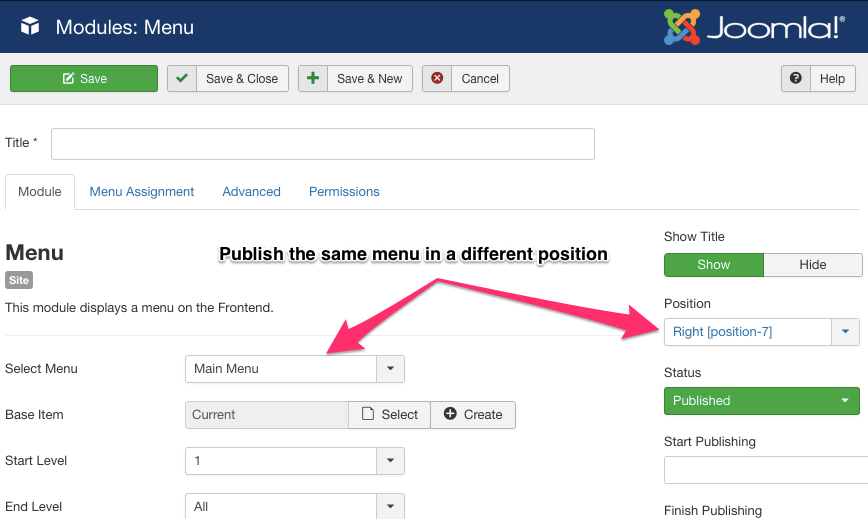
Using Menu item alias: You can find the feature in Joomla as follow: Add new menu item-> Menu item type -> Choose select -> System links -> Menu item alias
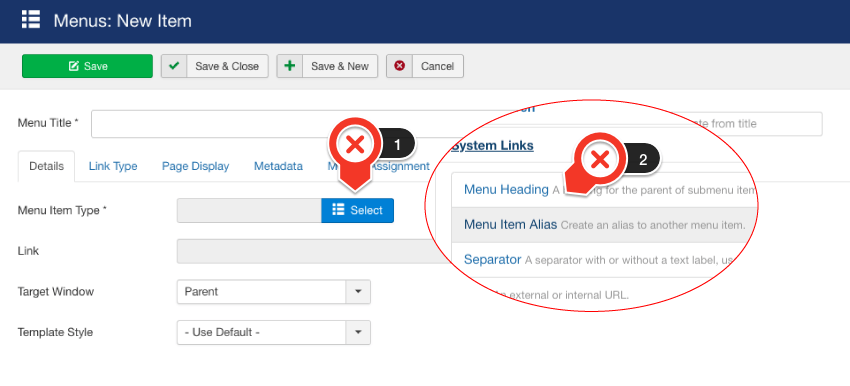
2. Use 301 redirects
The 301 redirects are a technical way to direct both users and search engine bots to go to another address after clicking or typing a specific URL.
Solution: For Joomla users (step applicable to any website platform) can apply 301 redirects as follows:
- Advanced rules in .htaccess
- Using redirect extension: There are many redirect extensions in Joomla. You can search in extension.joomla.org. However, ReDj is the most popular and effective according to Joomla community. So, my suggestion falls on this extension.
I recommend you choose option 2.
Advanced rules in .htaccess:
It usually looks like the code below: .htaccess
RewriteEngine On
RewriteCond %{REQUEST_FILENAME} !-f
RewriteCond %{REQUEST_FILENAME} !-d
RewriteRule ^(.+)/$ http://%{HTTP_HOST}/$1 [R=301,L]
For more .htaccess rules, you could read this helpful guide.
Read also: The editor has encountered an unexpected error (WordPress error)
3. Canonical tag
This is a way of telling search engines that a specific URL represents the master copy of a page. It aids to overcome problems caused by identical or “duplicate” content appearing on multiple URLs
For example, a page can be reached in 2 ways:
https://www.domain.com/index.php?option=com_content&Itemid=125&catid=15&id=18&lang=en&view=article
or
https://www.domain.com/abc
If we insert the canonical tag after the section of the first link, it will tell Google that the second URL is the original, please index that one only.
The canonical tag is easy to use in a traditional website that is built just by HTML and other web design code. But this is for someone that has no coding knowledge using Joomla just like other CMS platforms.
It can be time-consuming for a Joomla user beginner as he/she has to research a lot to be able to fix this. But with the use of the plugin on Joomla, you can do this within few minutes.
There is a Free plugin called “Custom Canonical” on Joomla that can help you insert a canonical tag in articles, categories, tags, or menu items without hassle.
How to use the plugin to fix canonical issues on Joomla
- Download and install the plugin
- Go to Extensions/Plugins to enable the plugin called “Custom Canonical”.
- Naviagte to Content/Articles, click the Publishing tab.
- Enter the original article URL to the “Canonical URL” field.
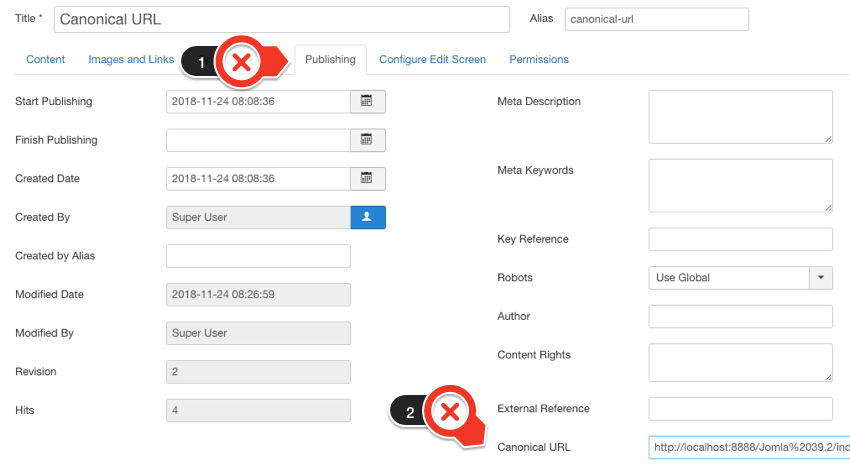
The canonical tag is the only way for a Joomla webmaster to deal with duplicate content both on and off the site. You can combine this with other solutions offered on this post to rid your site of duplicate issues.
4. Meta Tag Robots
A better way to prevent duplicate content is the use of a meta tag robot to block a page from being indexed by search bots. This can be done easily on Joomla
You can find this feature in the Publishing tab of any article, category, or menu item option in Joomla.
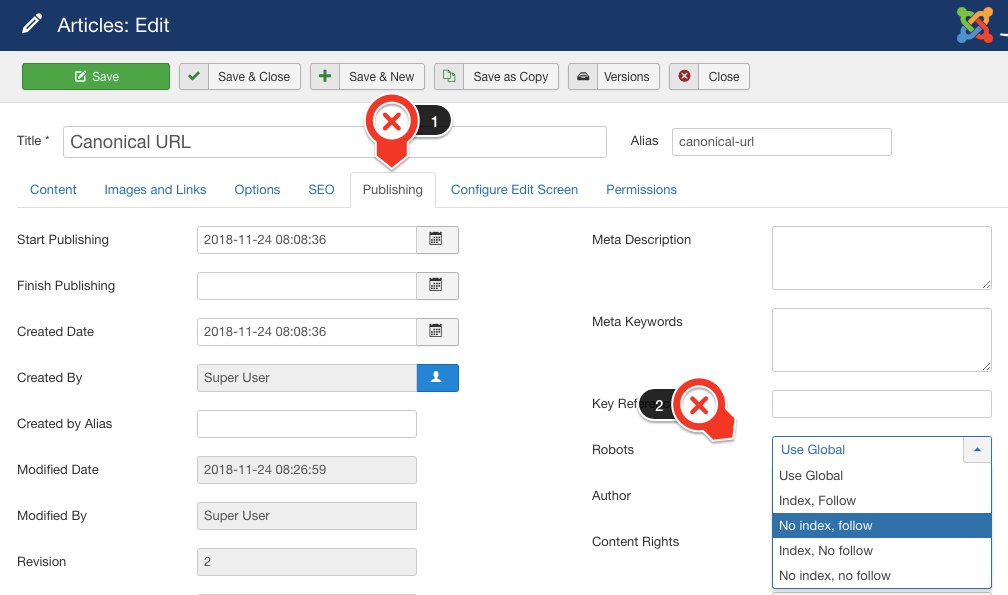
Change the Robots field into No index.
In a situation whereby you have 2 identical articles, you can tell Google not to index one of them, search bots will have to index the others.
Note:
- FOLLOW – a command for the search engine bot to follow the links in that page
- INDEX – a command for the search engine bot to index that page
5. Using an extension
This method is suitable for sites with a huge amount of pages. ie, a large site. From research and post by other cool bloggers I respect, I got the following
For smaller sites, you can prevent the duplicate content issue by configuring htaccess file, robots.txt, canonical tag and possibly an extension for 301-redirects.
- SH404SEF: Reviews showed it as one of the best SEO extensions for Joomla. It can help you with redirect task, insert metadata, canonical
- JoomSEF: Possess similar features as sh404SEF, with it, you can manage your duplicate content issue
- ReDJ: extension built for just Redirect.
- Custom Canonical: Designed for adding a canonical tag. Free and easy to use.
- Styware plugin: This plugin is also for adding a canonical tag in an article and category.
- Meta man: allow you to manage your site metadata efficiently.
6. Submit sitemap
The Sitemap is a protocol that permits a webmaster to inform search engines about URLs on a website that are available for crawling. It is an XML file that lists the URLs for a site.
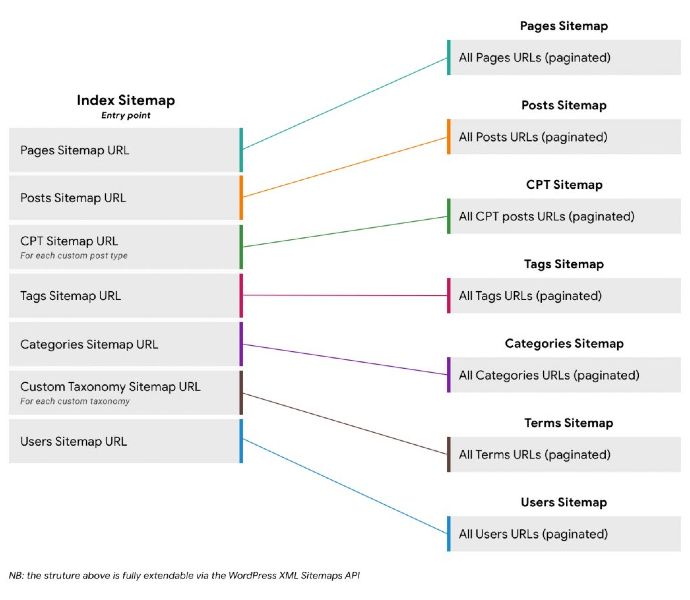
It also helps search bots crawl your site faster. How does this help to resolve the duplicate issue? search engine views the URLs in the sitemap as canonical URLs.
For large sites, a sitemap could be a very efficient way to deal with duplicate content.
There is an extension on Joomla to help with these extensions.
7. Using Google Search Console
Google Search Console is a powerful free tool that is available for you to use. Ensure Setting up your Google Search Console for SEO to aid you with visibility into your webpages’ performance in search results. By using the Search results tab under Performance, you can find URLs that may be causing duplicate content issues.

Check for these common copy issues:
- HTTP and HTTPS versions of the same URL
- www and non-www versions of the same URL
- URLs with and without trailing slash “/”
- URLs with and without query parameters
- URLs with and without capitalizations
- Long-tail queries with multiple pages ranking
There are 3 ways we can use these tools to get rid of copy contents:
- Submit sitemap:
- Choose preferred domain – to deal with www or non-www issue
- Using Parameter
Conclusion:
We can see from the post above that you can resolve duplicate content in Joomla and also WordPress and Drupal as the problems are the same and the method of resolution is almost alike just a few differences and technicalities. Trust this post has been helpful? you can leave a comment and we will get back to you. Kindly share with the social buttons below for others to also gain knowledge.
